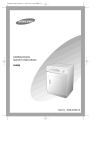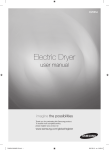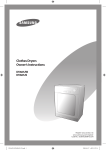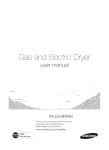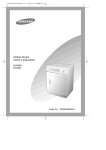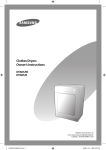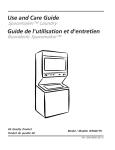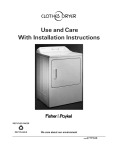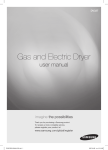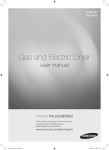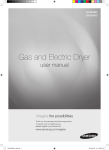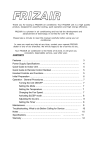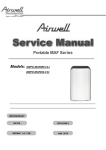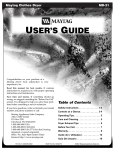Download Samsung DV665JW/XSA User Manual
Transcript
DV665J* Electric Dryer user manual imagine the possibilities Thank you for purchasing this Samsung product. To receive more complete service, please register your product at www.samsung.com/global/register DV665J-02658A_EN.indd 1 2009-01-12 ø¿¿¸ 9:37:07 features 1. Delay Start You can delay the dryer’s start-up time for up to 24 hours. The Delay Start feature will allow you to dry your clothes at a time that is convenient for you. 2. Freshen-up Program Samsung’s Freshen-up program tumble-dries garments in cool air set at a time of your choice, for up to 50 minutes. This program makes it easy to freshen-up clothes that only require a little airing out. 3. Sensor Dry & Fuzzy Logic Control Both technologies bring you outstanding economic benefits as well as excellent drying performance. The Fuzzy Logic Control determines the dryness and gentleness needed for your laundry and sets the appropriate drying time/cycle. The Sensor dry function continuously measures the temperature in the inner section of the dryer to provide excellent drying performance. 4. Various Drying Cycles & Fuzzy Logic Algorithm Simply turn the Jog Dial to select one of the 11 automatic drying cycles, including normal, heavy duty and towels. You can also choose to use the Fuzzy Logic Algorithm to measure the degree of dampness and automatically set the drying time. Precision drying has never been easier than with Samsung. 5. Wrinkle-Release Our Wrinkle-Release program tumble dries garments in warm air for 10 minutes, then cool air for an additional 10 minutes. You can use the Wrinkle-Release program to smooth the wrinkles of garments that have been stored away. 6. Stacking Samsung Washers and Dryers can be stacked to maximize usable space, using an optional Stacking Kit. 2_ Features DV665J-02658A_EN.indd 2 2009-01-12 ø¿¿¸ 9:37:07 safety instructions Congratulations on the purchase of your new Samsung Dryer. This manual contains valuable information on the installation, use, and care of your appliance. Please take the time to read this manual to take full advantage of your dryer’s many benefits and features. WHAT YOU NEED TO KNOW ABOUT SAFETY INSTRUCTIONS Warnings and Important Safety Instructions in this manual do not cover all possible conditions and situations that may occur. It is your responsibility to use common sense, caution, and care when installing, maintaining, or operating your dryer. Always contact your manufacturer about problems or conditions you do not understand. IMPORTANT SAFETY SYMBOLS AND PRECAUTIONS WARNING CAUTION CAUTION: Risk of Fire Hazards or unsafe practices that may result in severe personal injury or death. Hazards or unsafe practices that may result in minor personal injury or property damage. Follow the information in this manual to minimize the risk of fire or explosion or to prevent property damage, personal injury, or death. Do not store or use gasoline or other flammable vapors and liquids near this or any other appliance. Do NOT attempt. Do NOT disassemble. Do NOT touch. Follow directions explicity. Unplug the power plug from the wall socket. Make sure the machine is grounded to prevent electric shock. Call the service center for help. Safety instructions _3 DV665J-02658A_EN.indd 3 2009-01-12 ø¿¿¸ 9:37:08 safety instructions Read all instructions before using the appliance. To reduce the risk of fire or explosion: CAUTION: Risk of Fire • • Do not dry items that have been previously cleaned, washed, soaked, or spotted with gasoline, dry cleaning solvents, or other flammable or explosive substances. They emit vapors that could ignite or explode. Any material that has been in contact with a cleaning solvent or flammable liquids or solids should not be placed in the dryer until all traces of these flammable liquids or solids and their fumes have been removed. There are many highly flammable items used in homes, such as acetone, denatured alcohol, gasoline, kerosene, some liquid household cleaners, some spot removers, turpentine, waxes, and wax removers Items containing foam rubber (may be labeled latex foam) or similarly textured rubberlike materials must not be dried on a heat setting. Heated foam rubber materials can, under certain circumstances, produce fire by spontaneous combustion. Children should be supervised to ensure that they do not play with the appliance. Before discarding or removing your dryer from service, remove the door to the drying compartment to prevent children or animals from becoming trapped inside. This appliance is not intended for use by persons (including children) with reduced physical, sensory or mental capabilities, or lack of experience and knowledge, unless they have been given supervision or instruction concerning use of the appliance by a person responsible for their safety. Do not reach into the appliance when the drum is moving. Do not install or store this appliance where it will be exposed to the weather. Do not tamper with controls. Do not repair, replace, or attempt to service any part of the appliance unless specifically recommended in the user-repair instructions. You must also have the skills necessary to service this appliance. Do not use fabric softeners or products to eliminate static unless recommended for dryer use by the manufacturer of the fabric softener or product. Clean the lint screen before or after each load. Keep the area around the exhaust opening and surrounding areas free from lint, dust, and dirt. The interior of the dryer and exhaust duct should be cleaned periodically by qualified service personnel. This appliance must be properly grounded. Never plug the power cord into a receptacle that is not grounded adequately and in accordance with local and national codes. See installation instructions for grounding this appliance. 4_ Safety instructions DV665J-02658A_EN.indd 4 2009-01-12 ø¿¿¸ 9:37:08 Do not sit on top of the dryer. Because of continuing product improvements, Samsung reserves the right to change specifications without notice. For complete details, see the Installation Instructions packed with your product before selecting cabinetry, making cutouts, or beginning installation. WARNING Ensure pockets are free from small irregularly shaped hard objects, foreign material, etc. ie. coins, knives, pins, etc. These objects could damage your dryer. Do not dry clothing with large buckles, buttons, or other heavy metal or solid things. Install and use in accordance with the manufacturer’s instructions. If it is unavoidable that fabrics that contain vegetable or cooking oil or have been contaminated by hair care products be placed in a tumble dryer they should first be washed in hot water with extra detergent – this will reduce, but not eliminate, the hazard. Oil-affected items can ignite spontaneously, especially when exposed to heat sources such as in a tumble dryer. The items become warm, causing an oxidation reaction in the oil. Oxidation creates heat. If the heat cannot escape, the items can become hot enough to catch fire. Piling, stacking or storing oil-affected items can prevent heat from escaping and so create a fire hazard. All washed and unwashed fabrics that contain vegetable oil or cooking oil can be dangerous. Washing these items in hot water with extra detergent will reduce, but not eliminate, the hazard. Always use the Cool Down cycle for these items to reduce their temperature. Never remove these items from the dryer hot or interrupt the drying cycle until the items have run through the Cool Down cycle. Never pile or stack these items when they are hot. Safety instructions _5 DV665J-02658A_EN.indd 5 2009-01-12 ø¿¿¸ 9:37:08 contents INSTALLING YOUR DRYER 7 7 8 10 10 10 11 11 11 12 12 12 12 13 13 13 14 15 Tools needed for installation See Exhaust Requirements Ducting requirements Exhaust directions Exhaust duct locating dimensions Important to installer Location considerations Alcove or closet installation Exhausting Electrical requirements Grounding Electrical connections Replacement parts and accessories Installation Final installation checklist ENVIRONMENT Dryer Exhaust Tips Door Reversal 16 18 Tips 18 18 19 20 21 21 21 Overview of the control panel Polyester Knits & Permanent Press Drying CARE AND CLEANING 22 22 22 22 23 23 23 Clean Filter Control Panel Stainless Steel Tumbler Dryer Exterior Dryer Exterior Dryer Exhaust Inside the dryer cabinet TROUBLESHOOTING 24 25 Questions? Use this problem solver Information Codes APPENDIX 26 27 27 Fabric Care Chart Protecting The Environment Specifications 7 OPERATING INSTRUCTIONS, TIPS 16 22 24 26 Loading Clothes Drying Times Cycle selecting guide Cycle Chart Clean the lint filter Load the dryer properly Getting started 6_ Contents DV665J-02658A_EN.indd 6 2009-01-12 ø¿¿¸ 9:37:08 installing your dryer TOOLS NEEDED FOR INSTALLATION SEE EXHAUST REQUIREMENTS 01 Installing your dryer Hire a professional to install this dryer properly. If there is a service call performed as a result of poor setup, adjustment, and connection, it is considered the responsibility of the installer. If you install the dryer you are responsible. Make sure you have everything necessary for proper installation. 1. A GROUNDED ELECTRICAL OUTLET is required. See Electrical Requirements on page 12. 2. EXHAUST SYSTEM – must be rigid metal or flexible stiff-walled metal exhaust ducting. See exhaust requirements on page 8. Control panel Door Level Pliers Cutting knife Nut drivers Phillips Screwdriver Duct tape Crescent spanner Installing your dryer _7 DV665J-02658A_EN.indd 7 2009-01-12 ø¿¿¸ 9:37:09 installing your dryer DUCTING REQUIREMENTS • • • • • • • • • • • • • • • • • • Use a 4-inch (10.2 cm) diameter rigid aluminum or rigid galvanized steel duct. Do not use a smaller duct. Ducts larger than 4 inches (10.2 cm) in diameter can result in increased lint accumulation. Lint accumulation should be cleaned regularly. If a flexible metal duct must be used, use the type with a stiff sheet metal wall. Do not use a flexible duct with a thin foil wall. Serious blockage can result if the flexible metal duct is bent too sharply. Never install any type of flexible duct in walls, ceilings, or other concealed spaces. Keep the exhaust duct as straight and short as possible. Secure joints with duct tape. Do not use screws. DO NOT EXHAUST DRYER INTO ANY WALL, CEILING, CRAWL SPACE, OR CONCEALED SPACE OF A BUILDING, GAS VENT, OR ANY OTHER COMMON DUCT OR CHIMNEY. THIS COULD CREATE A FIRE HAZARD FROM LINT EXPELLED BY THE DRYER. Plastic flexible duct can kink, sag, be punctured, reduce airflow, extend drying times, and affect dryer operation. Exhaust systems longer than recommended can extend drying times, affect machine operation, and may collect lint. The exhaust duct should end with an exhaust hood with a swing-out damper to prevent back drafts and entry of wildlife. Never use an exhaust hood with a magnetic damper. The hood should have at least 12 inches (30.5 cm) of clearance between the bottom of the hood and the ground or other obstruction. The hood opening should point down. Never install a screen over the exhaust outlet. To avoid lint buildup, do not exhaust the dryer directly into a window well. Do not exhaust under a house or porch. If exhaust ductwork must run through an unheated area, the duct should be insulated and slope slightly down towards the exhaust hood to reduce condensation and lint buildup. Inspect and clean the interior of the exhaust system at least once a year. Unplug the power cord before cleaning. Check frequently to be sure the exhaust hood damper opens and closes freely. Check once per month, and clean at least one time per year. Note: If clothes are not getting dry, then check ducting for obstructions. 8_ Installing your dryer DV665J-02658A_EN.indd 8 2009-01-12 ø¿¿¸ 9:37:10 EXHAUST LENGTH CALCULATION Table 1: RECOMMENDED MAXIMUM LENGTH ELECTRIC DRYERS * Recommended Use only for short run installations 4” (10 .16 cm) 2.5” (6.35 cm) No. of 90° elbows Rigid Metallic Flexible* Rigid Metallic Flexible* 0 14 m (46 ft.) 9 m (30 ft.) 11 m (37 ft.) 7 m (24 ft.) 1 11 m (38 ft.) 7.5 m (25 ft.) 9 m (30 ft.) 6 m (20 ft.) 2 9 m (31 ft.) 6 m (20 ft.) 6.5 m (22 ft.) 4 m (14 ft.) 3 7 m (24 ft.) 5 m (16 ft.) 4.5 m (15 ft.) 3 m (10 ft.) 01 Installing your dryer Weather Hood Type Do not use non-metallic flexible duct. If the new dryer is installed into an existing exhaust system you must make sure: • The exhaust system meets all local, state, and national codes. • That a flexible plastic duct is not used. • To Inspect and clean all lint buildup from inside the existing duct. • The duct is not kinked or crushed. • The exhaust hood damper opens and closes freely. The static pressure in any exhaust system must not exceed 0.83 inches of water column, or be less than 0. This can be measured with the dryer running with a manometer at the point where the exhaust duct connects to the dryer. A no-heat setting should be used. The dryer tumbler should be empty and the lint filter clean. Installing your dryer _9 DV665J-02658A_EN.indd 9 2009-01-12 ø¿¿¸ 9:37:10 installing your dryer EXHAUST DIRECTIONS All dryers shipped from the factory are set up for rear exhausting. However exhausting can be on the right, left or bottom of the dryer. Remove the access panel at back of dryer to gain access to the internal ducts. Disconnect the duct exhaust from the blower housing. Remove the desired knockout plate (either right or left side). Attach a 90° elbow duct to the blower housing and facing desired opening. Reinstall the rear access panel. 4-3/8”(11cm) Same as other side 3-3/4”(9.5cm) 5-7/8”(15cm) Front of dryer • • • • • Blower Housing Duct Exhaust 3-3/4”(9.5cm) 13-1/2”(34cm) EXHAUST DUCT LOCATING DIMENSIONS WARNING Non-metallic ducts must never be used inside the dryer cabinet. SPECIAL ACCESSORY Stacking kit (Model no:SK-2A) You can obtain the stacking kit from your retailer. With this kit you can combine your Samsung dryer with a Samsung washing machine in a washing and drying column. The appliances are stacked in a space-economizing manner in this arrangement, the washing machine on the bottom and the dryer on the top! IMPORTANT TO INSTALLER Please read the following instructions carefully before installing the dryer. These instructions should be kept for future reference. WARNING REMOVE THE DOOR FROM ALL DISCARDED APPLIANCES TO AVOID THE DANGER OF A CHILD SUFFOCATING. 10_ Installing your dryer DV665J-02658A_EN.indd 10 2009-01-12 ø¿¿¸ 9:37:11 LOCATION CONSIDERATIONS ALCOVE OR CLOSET INSTALLATION WARNING • • • • The dryer must be exhausted to the outside to reduce the risk of fire when installed in an alcove or closet. 01 Installing your dryer The dryer should be located where there is enough space in front for loading the dryer, and enough space behind for the exhaust system. This dryer is factory-ready for rear exhaust. To exhaust out the bottom or the left, inquire at the installer. It’s important to make sure the room has enough fresh air. The dryer must be located where there is no air-flow obstruction. THE DRYER MUST NOT BE INSTALLED OR STORED IN AN AREA WHERE IT WILL BE EXPOSED TO WATER AND/OR WEATHER. THE DRYER AREA IS TO BE KEPT CLEAR OF COMBUSTIBLE MATERIALS, GASOLINE, AND OTHER FLAMMABLE VAPORS AND LIQUIDS. A DRYER PRODUCES COMBUSTIBLE LINT. THE AREA AROUND THE DRYER SHOULD BE KEPT LINT-FREE. No other fuel-burning appliance should be installed in the same closet as the dryer. WARNING: To reduce the risk of fire, this dryer MUST BE EXHAUSTED TO THE OUTDOORS. See EXHAUST INFORMATION section. Minimum clearances between the dryer and adjacent walls or other surfaces are: 2” in front, 17” on top, 1” on either side, and 2.375” in the back. The closet front must have two unobstructed air openings for a combined minimum total area of 72 in² with 3” minimum clearance on the top and bottom. A louvered door with equivalent space clearance is acceptable. EXHAUSTING Exhausting the dryer to the outside will prevent large amounts of lint and moisture from being blown into the room. Installing your dryer _11 DV665J-02658A_EN.indd 11 2009-01-12 ø¿¿¸ 9:37:11 installing your dryer ELECTRICAL REQUIREMENTS A Wiring diagram is located on the inner top cover. • WARNING • Improper connection of the equipment grounding conductor can result in a risk of electric shock. Check with a qualified electrician or serviceman if you are in doubt as to whether your dryer is properly grounded. Do not modify the plug provided with your dryer – if it doesn’t fit the outlet, have a proper outlet installed by a qualified electrician. To prevent unnecessary risk of fire, electrical shock, or personal injury, all wiring and grounding must be done in accordance with local codes, or in the absence of local codes, with the National Electrical Code – Latest Revisions and local codes and ordinances. It is your responsibility to provide adequate electrical services for your dryer. GROUNDING This dryer must be grounded. In the event of a malfunction or breakdown, the ground will reduce the risk of electrical shock by providing a path of least resistance for the electrical current. Electric models Your dryer has a cord with an equipment-grounding conductor and a grounding plug, sold separately. The plug must be plugged into an appropriate outlet that is properly installed and grounded in accordance with all local codes and ordinances. If a power cord is not used and the electric dryer is to be permanently wired, the dryer must be connected to a permanently grounded metal wiring system, or an equipment grounding conductor must be run with the circuit conductors and connected to the equipment grounding terminal. ELECTRICAL CONNECTIONS Before operating or testing, follow all grounding instructions in the Grounding section on page 11. An individual branch (or separate) circuit serving only your dryer is recommended. DO NOT USE AN EXTENSION CORD. REPLACEMENT PARTS AND ACCESSORIES If your dryer requires replacement parts or accessories, contact the dealer from whom you purchased your dryer or the SAMSUNG customer care center at 1300 362 603. 12_ Installing your dryer DV665J-02658A_EN.indd 12 2009-01-12 ø¿¿¸ 9:37:11 INSTALLATION 01 Installing your dryer For proper installation, it is highly recommended to hire a professional. To install: 1. Move your dryer to an appropriate location for installation. Consider installing the dryer and washer sideby-side, to allow access to electrical and exhaust connections. Lay two of the carton cushion-tops on the floor. Tip your dryer on its side so it will lay across both cushion-tops. 2. Set your dryer back in an upright position. 3. Review the Exhausting section before installing the exhaust system. Install the ductwork from your dryer to the exhaust hood. The crimped end of the duct sections must point away from your dryer. DO NOT use sheet metal screws when assembling ducting. These joints should be taped. Never use plastic flexible exhaust material. Tip for tight installations: install a section of the exhaust system to your dryer before putting it in place. Use duct tape to secure this section of the exhaust system to your dryer, but do not cover the ventilation slots at the back of the unit. 4. Review Electrical Requirements section on page 11. BEFORE OPERATING OR TESTING, follow the grounding instructions in the Grounding section on page 11. Remove the terminal block cover plate. Insert the power cord with a UL-listed strain relief through the hole provided in the cabinet near the terminal block. A strain relief must be used. Do not loosen the nuts already installed on the terminal block. Be sure they are tight. Use a 3/8” (1cm) deep well socket. 5. With a level, check your dryer and make necessary adjustments to the leveling legs. 6. At this time, make sure all exhaust and electrical connections are complete. Plug in your dryer, and check operation by using the checklist below. FINAL INSTALLATION CHECKLIST Dryer is plugged into electrical outlet and properly grounded. Exhaust ductwork is hooked up and joints taped. Plastic flexible duct is NOT used. Used rigid or stiff-walled flexible metal vent material. Dryer is level with all legs firmly on the floor. Start your dryer to confirm that it runs, heats, and shuts off. ENVIRONMENT Please dispose of the packaging materials for this product in an “environmentally friendly” manner. For further detail, please contact your local area authority. Installing your dryer _13 DV665J-02658A_EN.indd 13 2009-01-12 ø¿¿¸ 9:37:11 installing your dryer DRYER EXHAUST TIPS Plastic or non-metal flexible duct presents a potential fire hazard. 1. Let your dryer exhaust the air easily. WARNING 2. Use a 4” diameter rigid metal duct. Tape all joints, including at the dryer. Never use lint-trapping screws. 3. Keep ducts as straight as possible. 4. Clean all old ducts before installing your new dryer. Be sure that the vent flap opens and closes freely. Inspect and clean the exhaust system annually. Don’t let a poor exhaust system slow drying by: 1. Restricting your dryer with a poor exhaust system. 2. Using a plastic, thin foil, or non-metal flexible duct. 3. Using unnecessarily long duct runs with many elbows. 4. Allowing crushed or clogged ducts and vent. 1 2 3 4 14_ Installing your dryer DV665J-02658A_EN.indd 14 2009-01-12 ø¿¿¸ 9:37:13 DOOR REVERSAL 01 Installing your dryer 1. Disconnect the power supply to the unit. 2. Remove the top screw on the top hinge. Loosen but do not remove the lower screw on the top hinge. Repeat the procedure for the lower hinge. 3. Lift the door and remove it from the dryer. 4. Remove 4 screws around the perimeter of the door. 5. Remove the door skin to expose the inner door panel. 6. Remove the internal door and hinge components and reassemble them to the opposite side of the Inner Door Panel. 7. Reattach the outer door skin to the Inner Door Panel. 8. Remove 4 screws around the perimeter of the door. Installing your dryer _15 DV665J-02658A_EN.indd 15 2009-01-12 ø¿¿¸ 9:37:15 operating Instructions, tips OVERVIEW OF THE CONTROL PANEL During the DRY cycle, the displayed remaining time may be increased or decreased. This is not a malfunction. The unit is adjusting the drying time to dry your clothes thoroughly. When using the dryer, please use loads less than 8lb to get the best drying results. (Max. DRY time is 3 hours.) 1 SIGNAL BUTTON When the signal button is OFF, the completion buzzer does not make a sound. Push the SIGNAL button to turn the SIGNAL indicator and completion buzzer ON. 2 TEMP BUTTON The TEMP button is set to OFF(HIGH temp) by default. Push the TEMP button to set the LOW temperature and the Low Temp indicator will turn ON. 3 TIME BUTTON When you press the TIME button, 1:25 minutes is displayed. You can decrease the time in 10 minute intervals by pushing the TIME button. (1:25,1:15,1:05.............. 25,15,1:25) 4 DELAY START BUTTON Press the DELAY START button repeatedly to cycle through the available delayed start options (from 1 to 24 hours in one hour increments). 5 WRINKLE RELEASE BUTTON Wrinkle Release will provide 10minutes of tumbling in heated air and 10 minutes of tumbling in unheated air. Press the Wrinkle-Release button to activate this feature. CYCLE SELECTOR To select a cycle, turn the Cycle Selector dial to the desired cycle. Cotton+More Dry Cotton+Normal Dry Cotton+Less Dry Cotton+Damp Dry Air Fluff Synthetic+Intensive Dry Synthetic+Very Dry Synthetic+More Dry Synthetic+Normal Dry Synthetic+Less Dry Synthetic+Damp Dry Air Fluff Cotton+Intensive Dry Cotton+Very Dry Cotton+More Dry 6 16_ operating Instructions, tips DV665J-02658A_EN.indd 16 2009-01-12 ø¿¿¸ 9:37:15 When you turn the dryer on, the FILTER LAMP will flicker 3 times. When a drying cycle is finished, the FILTER LAMP will turn ON. Cleaning instructions for the filter will appear on the DISPLAY. 8 CHILD LOCK INDICATOR To activate the CHILD LOCK, push the WRINKLE-RELEASE button and DELAY START button in order. The CHILD LOCK INDICATOR will illuminate and all buttons, except the POWER BUTTON, will be inoperable. To cancel the CHILD LOCK, push the DELAY START button and WRINKLERELEASE button in order. 9 START/PAUSE BUTTON Press this button to start and pause the drying cycle. POWER BUTTON To turn the dryer ON press the POWER button once. Press the POWER button twice to turn the dryer OFF. When the dryer is ON for longer than 10 minutes without pressing any buttons, it will automatically turn OFF. 10 02 operating Instructions, tips FILTER LAMP 7 operating Instructions, tips _17 DV665J-02658A_EN.indd 17 2009-01-12 ø¿¿¸ 9:37:16 operating Instructions, tips HOW TO OPERATE YOUR DRYER TO DRY CLOTHES USING THE DRYING CYCLES 1. 2. 3. 4. 5. Open the door and put the laundry in the dryer. Press the power button. Turn the Cycle Selector Dial to choose the cycle. You will see the indicators light up on the control panel. Set the Temp. button to the desired position: Off(Default): High, On(Push In): Low Press the Start/Pause button and the dry cycle will begin. TO DRY CLOTHES MANUALLY 1. Open the door and put the laundry in the dryer. 2. Press the power button. 3. Press the Time button to set the drying time. You can decrease the time in 10 minute intervals by pushing the TIME button. (1:25,1:15,1:05.............. 25,15,1:25) 4. Press the Start/Pause button and the dry cycle will begin. POLYESTER KNITS & PERMANENT PRESS DRYING TIPS • • • DO NOT OVERLOAD THE DRYER - Garments being dried or dewrinkled should tumble freely. REMOVE CLOTHES PROMPTLY - To help prevent wrinkling, remove clothes from the dryer promptly at the end of the drying cycles. PLACE GARMENTS ON HANGERS - Permanent press and polyester knit garments look best if placed on hangers after drying. LOADING CLOTHES • • • • CAUTION • • • Don’t overload your dryer. Crowded loads don’t dry efficiently and clothes may be unnecessarily wrinkled. As a general rule, sort clothes by surface texture, fabric, color and weight, as you would for your washer. Do not add fabric softener sheets once the load has become warm. Do not dry the following items: fiberglass items, woolens, rubber- coated items, plastics, items with plastic trim and foam-filled items. Clothing with metallic components may damage the drum interior while drying. The display indicates the remaining drying time by automatically calculating the quantity of clothing and the content of water. During the first phase of the drying cycle, the display will indicate the total estimated drying time. During the drying cycle, you will again be able to verify the degree of dryness of the clothing and then increase or decrease the remaining time according to the desired results. (Max. DRY time is 3 hours) DRYING TIMES It is impossible to give exact drying times. Conditions from home to home vary and directly affect drying times. The length of time it takes to dry loads will depend on several things. • Load Size • Type of fabric, washer, and spin speed will determine moisture in the fabric. • Heat and moisture in the room. Damp air coming into the dryer will increase drying time. • Installation (Length of exhaust duct, etc) • Electric voltage. If you select an automatic cycle, the machine will determine the time needed for drying. During the DRY cycle, the remaining time may be increased or decreased in order to optimize dryness. 18_ operating Instructions, tips DV665J-02658A_EN.indd 18 2009-01-12 ø¿¿¸ 9:37:16 CYCLE SELECTING GUIDE Programs Example for Track suits, Towelling materials, bath robes Fabrics of medium weight, articles not made up of mult-layers Jeans, Towel laundry, hand towels Normal cotton and linen articles Sheets, and pillowcase, tablecloths, cotton trousers Normal Dry Lightweight materials Cotton shirt and underwear Less Dry Cotton and linen articles to be ironed. Tablecloths and shirts Damp Dry For leaving items partially damp Cotton underwear Heavyweight or multi-layered fabrics Sweatshirts, bed linen and table linen Fabrics of medium weight Easycare fabric shirts, baby clothes and wool More Dry Normal synthetic fabrics Delicate dresses, skirts, shirts Normal Dry Lightweight materials Blouses, dress shirts Less Dry Very delicate fabrics Easy care fabric and blouses Damp Dry For leaving items partially damp Delicate underwear Very Dry Cotton More Dry Intensive Dry Very Dry 02 operating Instructions, tips Heavy weight or mult-layered fabrics Intensive Dry Synthetic Laundry Type operating Instructions, tips _19 DV665J-02658A_EN.indd 19 2009-01-12 ø¿¿¸ 9:37:16 operating Instructions, tips CYCLE CHART Low Temp Select Delay Start Estimated Time (8lb/3.6kg) Intensive Dry Yes 1 hr 36 min Very Dry Yes 1 hr 33 min Yes 1 hr 30 min Yes 1 hr 23 min Less Dry Yes 1 hr 18 min Damp Dry Yes 1 hr 08 min Intensive Dry Yes 1 hr 26 min Yes 1 hr 23 min Yes 1 hr 20 min Normal Dry Yes 1 hr 13 min Less Dry Yes 1 hr 08 min Damp Dry Yes 58 min No No 20 min Time Dry High/Low No 15 min ~ 1hr 25 min Air Fluff No No 10 ~ 50 min Programs Cotton More Dry Normal Dry Very Dry Synthetic More Dry Wrinkle-Release High/Low Low Remark No Heating 20_ operating Instructions, tips DV665J-02658A_EN.indd 20 2009-01-12 ø¿¿¸ 9:37:16 CLEAN THE LINT FILTER • • • After each load. To shorten drying time. To operate more energy efficiently. LOAD THE DRYER PROPERLY • • • • Place only one washload in your dryer at a time. Mixed loads of heavy and lightweight fabrics will dry differently, which may result in lightweight fabrics being dry while heavy fabrics remaining damp at the end of a drying cycle. Add one or more similar items to your dryer when only one or two articles need drying. This improves the tumbling action and drying efficiency. Overloading restricts tumbling action, resulting in uneven drying as well as excessive wrinkling of some fabrics. 02 operating Instructions, tips Do not operate your dryer without the lint filter in place. GETTING STARTED 1. 2. 3. 4. 5. 6. Load your dryer loosely – DO NOT overload. Close the door. Select the appropriate cycle and options for the load (see page 19). Press the Start/Pause button. The dryer indicator light will illuminate. The estimated cycle time will appear in the display. The time may fluctuate to better indicate the drying time remaining in the cycle. • • • When the cycle is complete “End” will appear in the display. Pressing Power cancels the cycle and stops your dryer. The Drying and Cooling indicator lights will illuminate during those portions of the cycle. operating Instructions, tips _21 DV665J-02658A_EN.indd 21 2009-01-12 ø¿¿¸ 9:37:16 care and cleaning CLEAN FILTER Clean the filter before every dryer use Slide out the lint filter as shown. Put your moistened fingers at one corner of the filter and wipe in a sideways motion all the way across to the other corner. Do not operate the dryer without the filter in place. Periodically, remove the grid (it snaps in and out) and insert the suction hose adapter from your vacuum cleaner into the opening. Do the same through the rectangular opening at top or bottom of the door and at the louvers on the cabinet front. PULL CLEAN LINT FILTER AFTER EACH CYCLE CONTROL PANEL Clean with a soft, damp cloth. Do not use abrasive substances. Do not spray cleaners directly on the panel. The control panel finish may be damaged by some laundry pre-treatment soil and stain remover products. Apply such products away from your dryer and wipe up any spills or overspray immediately. STAINLESS STEEL TUMBLER To clean the stainless steel tumbler, use a damp cloth with a mild, non-abrasive cleaner suitable for stainless steel surfaces. Remove the cleaner residue and dry with a clean cloth. DRYER EXTERIOR Clean with a soft, damp cloth. Do not use abrasive substances. Protect the surface from sharp objects. 22_ care and cleaning DV665J-02658A_EN.indd 22 2009-01-12 ø¿¿¸ 9:37:16 DRYER EXTERIOR Clean with a soft, damp cloth. Do not use abrasive substances. Protect the surface from sharp objects. DRYER EXHAUST 1. Disconnect or turn off the electrical power. 2. Disconnect the exhaust duct from dryer. 3. Clean exhaust duct from the end where dryer is connected to the exhause hood using: • the hose attachment of your vacuum cleaner • a dust rag attached to a pole (for straight stretches) or a drain cleaning wire (for less accessible areas). 4. Inspect the exhaust hood. To minimize resistance to the exhaust air flow: • the flap must move freely (you may check with a mirror); • the flap should be fully open when the dryer in on; • ensure that no wildlife (birds, insects,...) have nested inside the duct. EXHAUST HOOD CONNECTED TO DRYER 03 care and cleaning MAXIMIZE YOUR DRYER EFFICIENCY BY KEEPING THE EXHAUST DUCT CLEAN. Check turns in the exhaust duct for any collected lint. INSIDE THE DRYER CABINET CLEANING LINT FROM YOUR DRYER Combustible lint may collect on the inside of the dryer cabinet. CLEAN EVERY 2 TO 3 YEARS OR MORE OFTEN DEPENDING ON USAGE. Cleaning should be done by a qualified service person. ALWAYS VERIFY PROPER OPERATION AFTER SERVICING care and cleaning _23 DV665J-02658A_EN.indd 23 2009-01-12 ø¿¿¸ 9:37:17 troubleshooting QUESTIONS? USE THIS PROBLEM SOLVER PROBLEM POSSIBLE CAUSE DRYER WON’T START • Dryer unplugged. Make sure the power cord is plugged in. • No power to dryer. Check fuses and circuit breakers to make sure dryer is getting current. • Dryer door is open. Close door securely - dryer will not run with door open. • Circuit is overloaded. Do not operate other appliances on the same electrical outlet or circuit while the dryer is operation. CLOTHES TAKE TOO LONG TO DRY • Controls improperly set. Check all controls to make sure they are correctly set for the load you want to dry. See the How to Operate Your Dryer section on page 18. • Clogged lint filter. Clean the filter before every load. Periodically remove lint filter and clean area under it with vacuum cleaner. See the Care and Cleaning section on page 23. • Obstruction in exhaust ducting. Make sure ducting is clean and free of obstruction; If flexible ducting is used, be sure it is not kinked and is properly installed according to the Installation Instructions. see page 15. • Blown fuses or tripped circuit breakers. Check household fuses or circuit breakers. Most electric dryers use two. It is possible for one to be blown or tripped and the dryer still tumbles without heat. • Improper sorting. Do not mix heavy, hard-to-dry items with lightweight article. • Large loads of moisture-holding fabrics, such as beach towels, take a long time to remove moisture. • Too many items in dryer. Dry only one washer load at a time. Do not combine loads. • Too few items in dryer. If drying only one article, add two more similar articles, even if dry, to ensure proper tumbling. GENERAL SHRINKAGE • Some fabrics will shrink whether machine washed and tumble dried or washed by hand and drip dried; others may be safely washed but will shrink in a dryer. Follow the Garments Manufacturers’ Care Label exactly. If in doubt, do not machine wash or tumble dry. WRINKLING • Leaving clothes in the dryer after tumbling stops. Remove clothes promptly and hang them immediately. • Improper loads. Avoid laundering heavy Permanent Press items, such as work clothes, with lighter Permanent Press items, such as shirts or blouses. Do not wash or dry Permanent Press with regular laundry. • Failure to use fabric softener. Proper use of fabric softener will minimize wrinkling. TO REMOVE WRINKLES Try one or more of these suggestions • If unsuccessful, retumble on high heat for 10-12 minutes and hang immediately • Iron carefully • Send to dry cleaners for pressing • Some wrinkles may remain which cannot be removed.* IF THE DRYER STILL DOES NOT OPERATE, call for Service. GIVE THE MODEL AND SERIAL NUMBER AND DESCRIBE THE SYMPTOMS OF THE DRYER. 24_ troubleshooting DV665J-02658A_EN.indd 24 2009-01-12 ø¿¿¸ 9:37:17 INFORMATION CODES Information codes may be displayed to help you better understand what is occurring with your Dryer. CODE SYMBOL SOLUTION Door open error when the door is open, the dryer will not operate. Be sure the door is latched shut. If problem continues, call for service. See below. For any codes not listed above, call 1300 362 603 04 troubleshooting MEANING troubleshooting _25 DV665J-02658A_EN.indd 25 2009-01-12 ø¿¿¸ 9:37:17 appendix FABRIC CARE CHART The following symbols provide garment care direction. The Clothing care labels include symbols for washing, bleaching, drying and ironing, or dry cleaning when necessary. The use of symbols ensures consistency among garment manufacturers of domestic and imported items. Follow care label directions to maximize garment life and reduce laundering problems. Wash Cycle Normal Permanent Press / Wrinkle Resistant / Wrinkle Control Gentle/Delicates Hand Wash Special Instructions Warning Symbols for Laundering Line Dry/ Hang to Dry Do Not Wash Drip Dry Do Not Wring Dry Flat Do Not Bleach Heat Setting Do Not Tumble Dry High No Steam (added to iron) Hot Medium Do Not Iron Warm Low Cold Any Heat Dry Clean No Heat/Air Do Not Dry Clean Water Temperature** Bleach Any Bleach (when needed) Only Non-Chlorine (color-safe) Bleach (when needed) Tumble Dry Cycle Iron-Dry or Steam Temperatures Dryclean Line Dry/ Hang to Dry High Drip Dry Medium Dry Flat Low Normal Permanent Press/ Wrinkle Resistant/ Wrinkle Control Gentle/ Delicates ** The dot symbols represent appropriate wash water temperatures for various items. The temperature range for Hot is 105° –125° F/ 41° – 52° C, for Warm 85° – 105° F/29° – 41° C and for Cold 60° – 85° F/16° – 29° C. (Wash water temperature must be a minimum of 60° F/16° C for detergent activation and effective cleaning.) 26_ appendix DV665J-02658A_EN.indd 26 2009-01-12 ø¿¿¸ 9:37:17 PROTECTING THE ENVIRONMENT SPECIFICATIONS TYPE DIMENSIONS FRONT LOADING DRYER Div Inches (ft) Div A. Height 33.25” (2.77) B. Depth C. Width 23.75” (1.98) D. Depth with door open 90° WEIGHT 77.16 lb HEATER RATING 2000 W POWER CONSUMPTION 2200 W ( 240V / 60Hz ) 05 appendix This appliance is manufactured from recyclable materials. If you decide to dispose of this appliance, please observe local waste disposal regulations. Cut off the power cord so that the appliance cannot be connected to a power source. Remove the door so that animals and small children cannot get trapped inside the appliance. Inches (ft) 22.83” (1.90) 40” (3.33) appendix _27 DV665J-02658A_EN.indd 27 2009-01-12 ø¿¿¸ 9:37:17 QUESTIONS OR COMMENTS? Country CALL OR VISIT US ONLINE AT AUSTRALIA 1300 362 603 www.samsung.com/au Code No. DC68-02658A_EN DV665J-02658A_EN.indd 28 2009-01-12 ø¿¿¸ 9:37:18




























